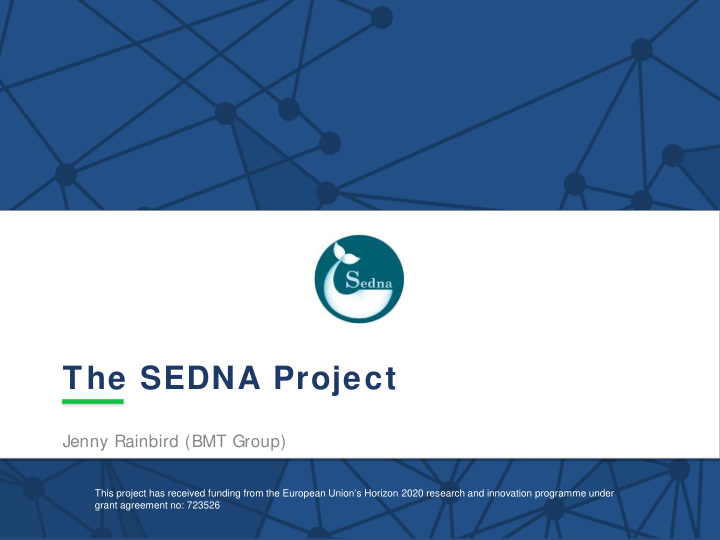



The SEDNA Project Jenny Rainbird (BMT Group) This project has received funding from the European Union’s Horizon 2020 research and innovation programme under grant agreement no: 723526
What is “SEDNA”? • SEDNA stands for “Safe maritime operations under extreme conditions: the Arctic case”. • SEDNA is a Horizon 2020 research project addressing topic MG-3.3-2016 (Safer waterborne transport and maritime operations). • SEDNA has started 1 June 2017 (i.e. last week) and will run for three years. • SEDNA’s budget is about €6.5 million 08/06/17
Consortium No. Name Country Expertise 1 BMT Group UK Project Management and ship modelling 2 University College London UK Anti-icing solutions voyage optimisation 3 Chalmers Technical University Sweden Voyage optimisation and bridge design 4 Architecture and Design University Oslo Norway Bridge design and Augmented Reality 5 University of Southampton UK Data science 6 MET Office UK Weather and sea ice forecasting Cork Institute of Technology Ireland Maritime human factors 7 Aalto University Finland Safe ship operations and risk-based design 8 Lloyd’s Register UK Maritime regulations and human elements 9 10 Aker Arctic Technology Finland End user – ship bridge technology Stena Rederi Sweden End user – shipping line 11 Dalian University of Technology China Arctic weather and sea ice forecasting 12 Harbin Engineering University China Modelling of ship-ice interaction 13 08/06/17
The Background • Due to global warming, larger parts of the Arctic waters are becoming navigable. • Hence, ship traffic in the Arctic regions is increasing fast over the last years. In particular, Arctic tourism on cruise ships has doubled between 2004 and 2007. • Moreover, it is estimated that around 13% of the world’s undiscovered oil is located in the Arctic. 08/06/17
Operational challenges in the Arctic • Highly variable and dynamic ice cover; • Ice build-up on vessels (affecting stability); • Changing wave climate; • Almost 24 hour darkness in winter; • Extreme air and water temperatures; • Lack of specific navigational aids; • Crews lack experience in Arctic waters; • Remoteness – far removed from help. 08/06/17
How w ill SEDNA address these issues? The project’s main objectives are as follows: 1. Create a human-centred “Safe Arctic Bridge” for ice-going vessels; 2. Combine ice monitoring and weather forecasting to optimise Arctic voyages; 3. Deliver anti-icing solutions for vessels; 4. Develop a ‘risk-based design framework’ to encompass all aspects of Arctic ship operation; 5. Analyse the safety of Methanol bunkering and the use of Low Flash Point Fuels in Arctic shipping. 08/06/17
The ‘Safe Arctic Bridge’ • Optimising Bridge design for the Arctic means focusing on ice, weather and lack of charts rather than ship traffic. • Development will be based on AHO’s virtual bridge prototyping system. • Using Augmented Reality (possibly Head Mounted Displays) can increase situational awareness on the bridge and thus improve decision making. 08/06/17
Arctic Voyage Optimisation • Develop a system for ship routing decision support. • Factors to be included: – Meteorological and oceanographic data sets – Models for the prediction of weather and ice conditions – Accuracy of hydrographic chart data – Models for ship performance and fuel efficiency • Integrate the output of these models into the Safe Arctic Bridge to provide crews with safest and (if possible) most efficient route. Polar Collective 08/06/17
Anti-icing engineering solutions • Ice build-up on vessel superstructures can dangerously affect the ship’s stability and interfere with navigation and communication equipment. • SEDNA will develop anti-icing coatings mimicking the super- hydrophobic properties of penguins’ feathers. Photo by Glenn Grant 08/06/17
Risk-based framework for safe ship design • Develop a design framework including the Arctic-specific challenges: – Ship-ice interaction – Integration of meteorological and oceanographic data to predict ice conditions – Previous accidents – Lack of specific human/machine interfaces and bridge technology • Ensure that safe ships are designed for use in Arctic environments • Determine extreme operational conditions for vessels according to their ice class, hence complement the IMO’s Polar Code. 08/06/17
Low Flash Point Fuels • Analyse safety risks in the bunkering of Methanol • Provide safety assessments for the use of LFPFs in the Arctic • Achieve a CEN Workshop Agreement (CWA) on the bunkering of Methanol • Write IMO Inf papers 08/06/17
Demonstration and Validation • We will test the outputs of the project in a variety of ways: – Usability testing in a simulated Arctic ship environment (Safe Arctic Bridge) – Field testing on real Arctic-going vessels (anti-icing coating) – End-user demonstration (Arctic Voyage Optimiser) – Test case study for a vessel in the Russian Arctic (Design Framework) • In addition, stakeholder workshops with industry experts will help to “keep things real”. 08/06/17
Thank you! 08/06/17
Recommend
More recommend